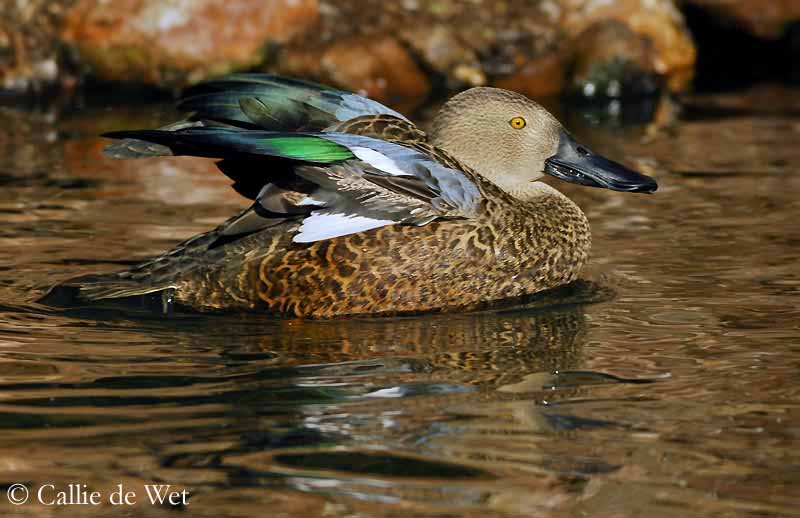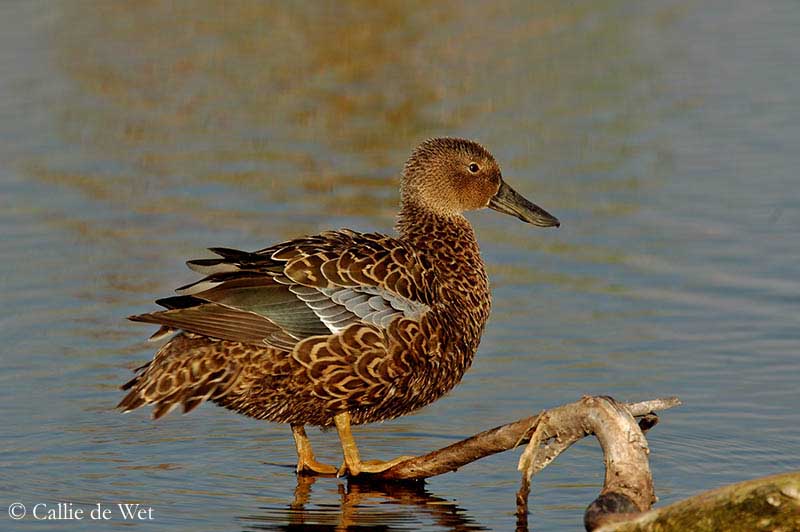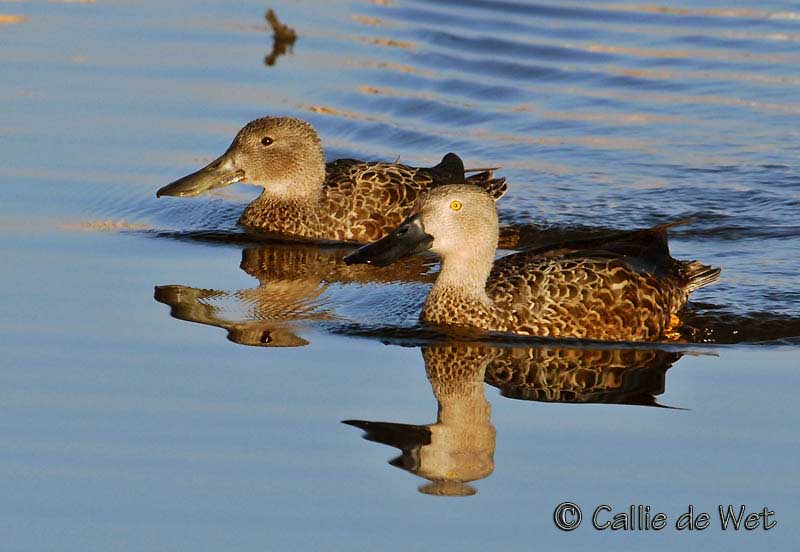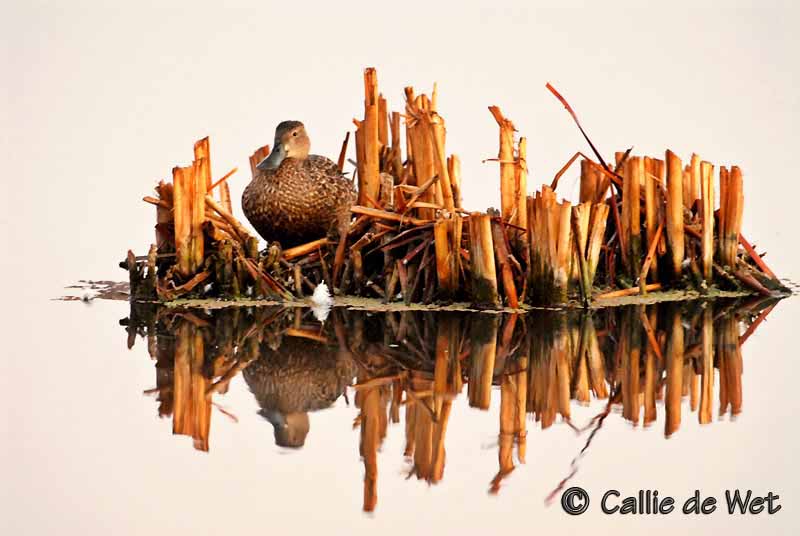
Cape Shoveler
Anas smithii
Anseriforme Order – Anatidae Family
BIOMETRICS:
Length: 51-53 cm
Weight: M : 688 g – F : 598 g
DESCRIPTION:
Cape Shoveler is a large brown duck with very large, flattened dark bill.

Adult male has dark brown upperparts and underparts, with a mottled effect given by pale edges’ feathers. It has greenish-black rump and upper tail feathers. Tail is dark brown. Tertials and scapulars are glossy bluish-black. Upperwing coverts are greyish-blue, with broad white tips on great coverts. Primaries are dark brown. Secondaries are metallic blue-green. Underwing is whitish, mottled with brownish leading edge. Flight feathers are greyish-brown.
Male has yellowish head and neck. Large spatula-shaped bill is dark. Eyes are yellow. Legs and webbed feet are bright orange-yellow.

Adult female is duller, but more mottled than male. Head and neck are darker and less contrasted than in male. Wings are duller, greyish, with indistinct pale tips on great coverts. Eyes are dark brown and bill is slightly smaller. Legs and webbed feet are greyish-yellow.
Juvenile resembles female, with more mottled plumage on upperparts. Young male reaches the wing colour pattern relatively soon.
VOICE: SOUNDS BY XENO-CANTO
Cape Shoveler is relatively silent. Male utters a strong “rrar”. Female utters series of quacking and isolated calls.
During courtship displays, male gives rasping “caouik” and a dry cackling. Other calls are uttered during nesting period.
HABITAT:
Cape Shoveler lives in temporary wetlands, freshwater lakes and ponds, estuaries, marshes with swallow brackish or fresh water and brackish coastal lagoons.
RANGE:
Cape Shoveler is endemic to South Africa. The species performs some dispersion and nomadism. It is common resident in south of Western Cape and uncommon across the rest of southern Africa.
BEHAVIOUR:
Cape Shoveler feeds in shallow water by dabbling. It swims forwards with head held low and horizontal bill in the water. In order to filter food out of the water, Cape Shoveler rapidly opens and closes its large bill. It also feeds while is walking, but it rarely eats aquatic plants or seeds.

Cape Shoveler is gregarious, usually seen in pairs or in small groups. During post breeding moult, they may gather up to several hundreds of birds. Pairs form after this period.
This species is usually sedentary, but it may perform dispersion within the range, according to the availability of suitable habitats.
FLIGHT:
Cape Shoveler has fast flight, with rapid wing beats. It can easily take off from the water.
REPRODUCTION:
Cape Shoveler’s nest is located in a depression on the ground, in low dense vegetation and close to the water. The nest is made with reeds, leaves and grasses. The interior is lined with down.
This species may breed in single pair or in loose colonies.
Cape Shoveler breeds all year round, varying with water level, but with a peak in summer. Nests may be close to each other.
Female lays 5 to 12 eggs. Incubation lasts about 27-28 days. Young fledge at about two months of age.

DIET:
Cape Shoveler feeds mainly on aquatic invertebrates, such as molluscs, tadpoles, crustaceans and insects. It sometimes feeds on aquatic plants and seeds, but less often than other ducks species.
PROTECTION / THREATS / STATUS:
Cape Shoveler is a common to locally common species in South Africa. Species has large population, but some decline, more than 30% in ten years and three generations, was observed. Cape Shoveler is evaluated as Least Concern.
Fr: Canard de Smith
All : Kaplöffelente
Esp : Cuchara de El Cabo
Ital : Mestolone del Capo
Nd : Kaapse Slobeend
Sd : Kapskedand
Photographs by Callie de Wet
GALLERY
Sources :
HANDBOOK OF THE BIRDS OF THE WORLD vol 1 by Josep del Hoyo-Andrew Elliot-Jordi Sargatal - Lynx Edicions - ISBN: 8487334105
GUIDE DES CANARDS, DES OIES ET DES CYGNES – de Steve Madge - Delachaux et Niestlé - ISBN: 2603013769
BIRDS OF AFRICA SOUTH OF THE SAHARA by Ian Sinclair and Peter Ryan - Princeton University Press Princeton and Oxford - ISBN: 0691118159
BirdLife International (BirdLife International)
Wikipedia (Wikipedia, The Free Encyclopedia)